Posts Tagged ‘Data Projects’
Orange County Workshop: Using Children’s Health Data in Your Work
 Attention everyone in Southern California who need children’s data for their work!
Attention everyone in Southern California who need children’s data for their work!
On Friday, Sept. 30, in Anaheim, we’re partnering with the UCLA Center for Health Policy Research and their HealthDATA team for a day-long workshop about finding and using data.
At this FREE workshop, you’ll learn how to formulate data questions, interpret results, export data for analysis, and use your findings in reports, presentations, proposals, and policy/program planning. Working directly with kidsdata.org, attendees will learn simple tips for obtaining health information for every city, legislative district, county, and school district in the state.
For more details, and to register, visit http://www.kidsdata.org/content/ucla-orange/Default.aspx
Posted by kidsdata.org
Tags: Data Projects, News About Kidsdata.org
Join Us for a Media Forum: Growing Up Poor in the Bay Area
 As the number of California children living in poverty has risen in recent years, key programs serving children and families have been cut. A media forum planned for next week aims to address these issues — and hopefully spur action.
As the number of California children living in poverty has risen in recent years, key programs serving children and families have been cut. A media forum planned for next week aims to address these issues — and hopefully spur action.
The New America Media forum, Growing Up Poor in the Bay Area, will be held on Wednesday, Sept. 14, from 10:30 a.m. to 1 p.m. in San Francisco, and is sponsored by the Lucile Packard Foundation for Children’s Health. This event will feature information about youth poverty from several perspectives:
- A presentation of local poverty data on kidsdata.org;
- Multimedia stories from youth reporters who will translate these data into real lives, describing how they’ve seen poverty affect local youth; and
- Comments/discussion from youth development organizations and others about troubling trends and recommendations for action.
We hope that this forum will help illustrate challenges faced by low income youth and families — and perhaps inspire some media coverage of these issues. Stay tuned to Data Points for a re-cap of this event.
If you’d like to attend Wednesday’s event, contact Dana Levine at [email protected] or 415-503-4170.
Posted by kidsdata.org
Tags: Child Health Issues, Data Projects
New Presentations Help Journalists, Others Use Census Data
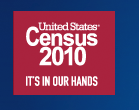 As results from the 2010 Census are released, the need for tools to help wade through all these data is becoming clear. To help address this, Arizona State University and the McCormick Foundation funded experts to create 40-minute how-to presentations to assist journalists and the public in using specific Census data. The presentations include information on comparing data among regions, using online maps, and analyzing trends. These presentations were featured in a recent Policy for Results blog.
As results from the 2010 Census are released, the need for tools to help wade through all these data is becoming clear. To help address this, Arizona State University and the McCormick Foundation funded experts to create 40-minute how-to presentations to assist journalists and the public in using specific Census data. The presentations include information on comparing data among regions, using online maps, and analyzing trends. These presentations were featured in a recent Policy for Results blog.
Posted by kidsdata.org
Tags: Data Projects, Data Sources
America’s Children: New Report Compiles Federal Data
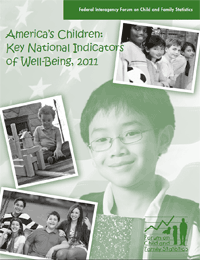 A new report released this week by the Federal Interagency Forum on Child and Family Statistics (a.k.a. ChildStats.gov) summarizes how American children are faring using 41 key indicators offered through federal data sources.
A new report released this week by the Federal Interagency Forum on Child and Family Statistics (a.k.a. ChildStats.gov) summarizes how American children are faring using 41 key indicators offered through federal data sources.
This annual report, America’s Children: Key National Indicators of Well-Being, 2011, aims to depict “both the promises and the challenges confronting our Nation’s young people.” The report includes measures of child well being in seven areas: family and social environment, economic circumstances, health care, physical environment and safety, behavior, education, and health.
Highlights include:
- Family structure data — married and single parents, and foreign-born parents (Also available on kidsdata.org)
- Adolescent birth rates (Also available on kidsdata.org)
- Child abuse rates (Also available on kidsdata.org)
- Children with working parents
- Health insurance coverage (Also available on kidsdata.org)
- Housing cost and adequacy (Also available on kidsdata.org)
- Adoption data
Posted by kidsdata.org
Tags: Data Projects, Data Sources
California Ranks 16th in Annual KidsCOUNT Data Book
The state of California ranks 16th in the 2011 KidsCOUNT Data Book, an annual profile of the status of children, released this week by the Annie E. Casey Foundation. The Data Book ranks states on 10 measures of child well being, and California’s ranking this year is an improvement since last year’s rank of 19.
In fact, the 2011 Data Book shows improvements for California in many areas, including the number of babies born at a low birthweight, child and teen deaths, teen births, and teens ages 16-19 not in school.
Some areas, however, do not show improvement. Infant mortality rates have increased slightly in recent years, according to National KidsCOUNT indicators. Additionally, the number of children living in poverty and living in single-parent families has increased, the Data Book shows.
In order to address the impact of the recession on California children, this year’s Data Book includes two new indicators: the number of children affected by foreclosure, and households with at least one unemployed parent.
In California, nearly 1 million children have been affected by foreclosure since 2007. And, in 2010, 1.2 million California children had a parent who was unemployed. Overall, the economic well-being for low-income children and families in California has declined significantly in the past decade, according to the Data Book.
Visit kidsdata.org for additional data by county, city, school district, and legislative district>>
Posted by kidsdata.org
Tags: Data Projects, Data Sources
Another Use for Kidsdata.org: See the Status of Kids in Your County
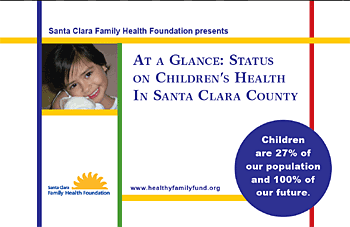 The Santa Clara Family Health Foundation’s data book “At a Glance: Status of Children’s Health in Santa Clara County” is an excellent example of how kidsdata.org can be used to facilitate discussions about child health issues.
The Santa Clara Family Health Foundation’s data book “At a Glance: Status of Children’s Health in Santa Clara County” is an excellent example of how kidsdata.org can be used to facilitate discussions about child health issues.
The 40-page booklet includes data about birth rates, teen births, and immunizations from kidsdata.org, and many other topics from other data sources, including health coverage, water fluoridation, and mental health. While this booklet focuses on Santa Clara County, a similar report could be made for any county in California.
Kudos to the health foundation for creating a valuable snapshot of the status of child health in its county. This book is a useful reference for elected officials and other local policymakers. View the data book>>
Posted by Felicity Simmons
Tags: Data Projects, Data Sources
A New Look at the History of American Families
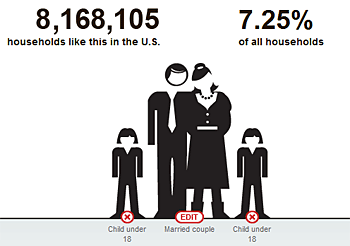 Have you ever wondered how many other families are just like yours?
Have you ever wondered how many other families are just like yours?
This interactive tool from the New York Times analyzes census data since 1900, and shows the make-up of households in the U.S. For example, in 2009, about 8 million households in the U.S. consisted of a married couple with two children (about 7% of all households). That’s almost the exact same percentage as in 1900.
As for other types of families, the percentage of households with single women and two children increased from about .4% to 1.6% in the last century, and recent data indicate that more than 62% of those households has an income below $30,000. Male unmarried partners with one child make up about 17,000 households in the U.S., and unmarried female partners with one child account for about 30,000 households.
If you’re looking for more local data, kidsdata.org has data on family structure for cities, counties, and school districts across California, including single parent households, and children in the care of grandparents.
Posted by kidsdata.org
Tags: Data Projects, Data Sources
Public Data’s New-Found Freedom
 The author of the emancipation proclamation for health data.
The author of the emancipation proclamation for health data.
That’s what Matt Miller, host of NPR’s “Left, Right & Center,” dubbed Todd Park at a national Health Data Initiative Forum in Bethesda, MD on June 9.
Park, chief technology officer for the U.S. Department of Health and Human Services (HHS), was instrumental in making HHS’s wide-ranging data offerings much more accessible, and is a pivotal figure in the federal government’s open data initiative.
Miller’s emancipation theme was pervasive at this one-day, Institute of Medicine forum. Speakers noted that at last year’s inaugural conference, technologists, communicators, and policymakers were trying to make sense of what to do with public data’s new-found freedom.
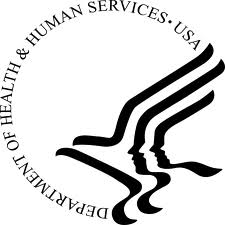 In just one year, Miller noted, numerous mature apps have emerged that utilize health data from the federal government in innovative and important ways. Many of these were featured at the forum, including Ozioma, which makes cancer-related data available to media; the Foodborne Disease Outbreak Investigation System, a public-private collaboration to investigate disease outbreaks; and Asthmapolis, which provides real-time data on asthma by tracking when – and where – people use their inhalers.
In just one year, Miller noted, numerous mature apps have emerged that utilize health data from the federal government in innovative and important ways. Many of these were featured at the forum, including Ozioma, which makes cancer-related data available to media; the Foodborne Disease Outbreak Investigation System, a public-private collaboration to investigate disease outbreaks; and Asthmapolis, which provides real-time data on asthma by tracking when – and where – people use their inhalers.
But while there are reasons for optimism, there were some pointed reminders, too, about the need to focus even more on how best to use all the data the federal government is releasing. For example, Harvey Fineberg, president of the Institute of Medicine, quoted Samuel Coleridge’s famous quote, “Water, water every where, nor any drop to drink.” Noting that “we’re “afloat in a sea of data,” Goldstein said that “information shall set you free, but only if you can use it.”
HHS Secretary Kathleen Sebelius pointed out that 30 years ago, “You often had little data; you made policy by anecdote.” Today, the situation is the same, she said, urging attendees to use data to help improve both health care costs and outcomes.
To help organize the burgeoning national interest in health data, HHS, the Institute of Medicine and the Robert Wood Johnson Foundation announced the formation of a national Health Data Consortium to help the country understand the power of health data and harness these data to make the U.S. a healthier nation. In addition to the organizations above, some of the other 15 founding members of the Health Data Consortium include our foundation, the California Health Care Foundation, Consumer Reports, Grantmakers in Health, and the National Association of Counties.
Posted by Andy Krackov
Tags: Data Challenges, Data Projects
A Portrait of Well Being in California
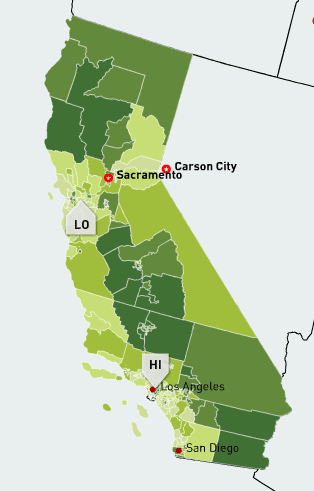 Here at the Lucile Packard Foundation for Children’s Health, we’re always on the lookout for compelling uses of data, so we took note of a report released this week by the American Human Development Project, “A Portrait of California.”
Here at the Lucile Packard Foundation for Children’s Health, we’re always on the lookout for compelling uses of data, so we took note of a report released this week by the American Human Development Project, “A Portrait of California.”
The report examines the well being of the people of California, using the American Human Development Index. Accompanying the index are interactive maps that show dozens of measures of health, including child poverty, life expectancy at birth, school enrollment, unemployment, and much more. Users also can find data by county, zip code, metro area, and even legislative district.
Here are a few highlights noted in the report’s fact sheets:
- Within the San Francisco metro area, life expectancy at birth ranges from 85 years in the San Mateo communities of Burlingame and Milbrae to only 74 years in the Elmhurst section of Oakland, an 11‐year gap within the same metro area.
- In Los Angeles, personal earnings are highest among whites, at $43,000 per year, followed by $35,000 for Asian Americans, $30,000 for African Americans, and $21,000 for Latinos.
- In the San Joaquin Valley, over 28 percent of adults have not completed high school.
See what’s happening in your community>>
Posted by kidsdata.org
Tags: Data Projects
Report Card Sheds Light on How Kids Are Faring in San Joaquin Valley
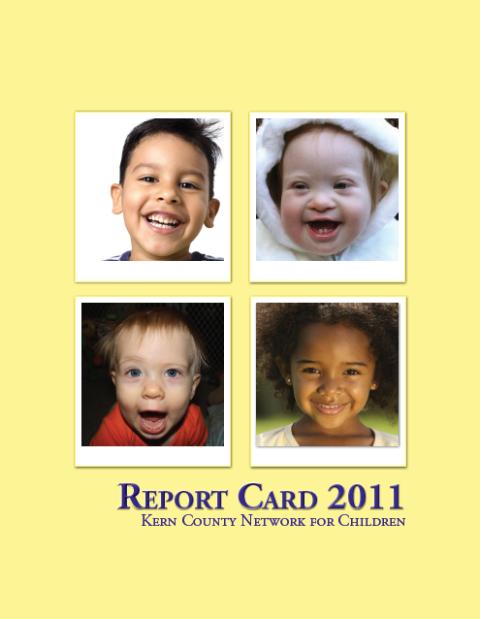 Widespread poverty emerged as the main headline in the Kern County Report Card, released this week by the Kern County Network for Children.
Widespread poverty emerged as the main headline in the Kern County Report Card, released this week by the Kern County Network for Children.
The report, which includes 160+ measures of child and youth well being, notes the toll that the recession has taken on youth in the area, with family income dropping, unemployment rising, and 25% of kids living below the federal poverty line. But the report showed some areas of improvement as well, including notable decreases in rates of child abuse and children in foster care.
We applaud the Kern County Network for Children for producing this report for 13 years, as data reports such as these help policymakers and community leaders make informed decisions on behalf of kids across California. To read the full report, visit http://www.kcnc.org/stories/storyReader$1328.
Also see data about Kern County kids on kidsdata.org, at http://www.kidsdata.org/kern.
Posted by kidsdata.org
Tags: Child Health Issues, Data Projects


